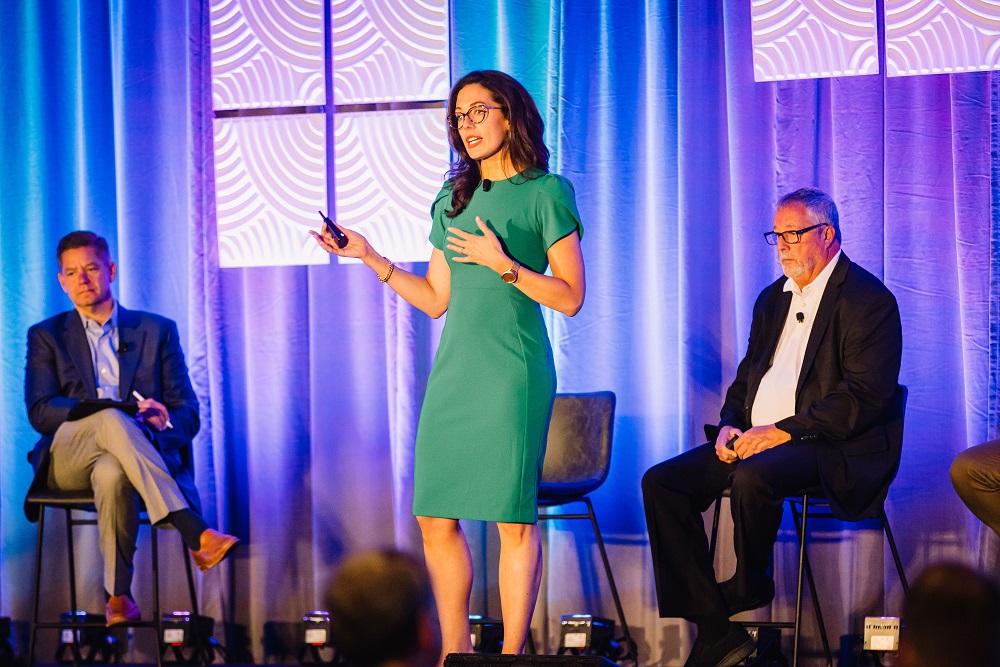Exploring careers beyond the non-profit and public sectors to maximize environmental impact
The following is an excerpt from Lauren Scott’s presentation at Distech Controls‘ CONNECT 2022 customer conference in both Dana Point California, and Chantilly, France.

I was six years old when I first knew that I would be involved in the environmental movement. I had gathered my toys, including prized Archie comics, and set up a garage sale in my parents’ driveway to raise money for the World Wildlife Fund.
For the years that followed, I assumed that, to leave this planet in a better place for the next generation, I would end up working for either a non-profit or the public sector.
And, to be honest, this idea that only charities or governmental bodies could move the environmental needle had been the shared narrative in western society for decades.
But something has switched over the past few years.
Suddenly, the private sector is now emerging as the leading sustainability protagonist.
Unquestionably, certain industries in the private sector are getting the lion’s share of airtime. Electric vehicles or even eco fashion are media favorites.
But what if it is actually our industry that holds a critical key in this solution? What if intelligent buildings are poised to unlock the next level of environmental opportunities?
How much of an opportunity?
According to a recent McKinsey report, the decarbonization of buildings could result in annual spending of $1.7 trillion per year globally on building assets alone between 2020 and 2050.
To further illustrate the extent of this potential opportunity, let us look at emissions.
If we return to the EV example, everyone seems very excited with the decarbonization of transportation, which currently accounts for 23% of global emissions.
And yet, sitting at 5 points above transportation is an even larger piece of the pie: building operations. While emitting more greenhouse gas emissions is nothing to be proud of, solving this problem is where the opportunity lies.
Our industry has long offered solutions to reduce the energy consumption of your customers’ buildings, so this is nothing new. However, an important opportunity will be to expand our horizon to one that emphasizes these very emissions.
With only 12.4% of US energy consumption coming from renewables, the reality is that a significant amount of our customers’ emissions are from their buildings. By reducing their energy consumption, they can:
- improve their ESG ratings
- reduce their reliance on foreign energy
- and increase the intelligent use for applications like energy storage and peak load avoidance
Furthermore, as organizations strive to achieve science-based emissions targets for years as far out as 2050, one of the barriers to action is not knowing what technology will be available decades from now. So, what can we do? Certainly, a key step is integrating technology that is open and connected.
By choosing to install future-ready technology, you are effectively reducing wasted time, money, and landfill. The connected nature of the ECLYPSE series allows you to connect to an ecosystem of the brightest minds both in your project’s building and beyond in finding the best way to minimize emissions.
Finally, our sector offers a key ingredient in the sustainability recipe: data. For years, you have been able to use the information from Distech Controls sensors to take meaningful action to reduce energy consumption and subsequent emissions.
Going a step further, this data is critical in terms of ESG reporting, an area many of us are now being asked by our customers to support. This past spring, the U.S. Securities and Exchange Commission (SEC) proposed a disclosure rule that would require reporting companies to provide certain climate-related information in their annual reports. Specifically, the proposed rules would require disclosure of Scope 1, 2 and, if material, 3 greenhouse gas emissions.
So what can you do to support your clients as they have to pivot in light of these changes?
Leveraging solutions that allow direct access to building data for formal ESG reporting including scope 1, 2 and 3 emissions will be key. Technology like Acuity Brands’ formal ESG reporting tool, Atrius Building Insights will play an important part of that journey.
But, in returning to the topic of emissions, something else becomes abundantly clear: no longer is an organization siloed away in its own operations. Even on a formal annual reporting level, our upstream and downstream relationships are key. Organizations are being asked to align closely with partners in providing full value-chain sustainability. Organizations like Target and Google are marching ahead with Net Zero targets, and are expecting their suppliers to keep up, even using sustainability performance scorecards to choose their list of preferred suppliers.
Our industry is in a very strategic spot to be able to have an important impact on emissions reductions over the coming years. This is truly a watershed moment for us to be able to come together, and support our stakeholders towards smarter, safer and greener buildings.
It has been 3 decades since I held that garage sale in my parents’ driveway.
While my dedication to leaving this planet in a better place for the next generation has been unwavering, my understanding of who will move the environmental needle has dramatically shifted.
The private sector is now our planet’s best hope to provide a better future for the next generation. In addressing this problem, there is a huge opportunity ahead of us that we are genuinely excited about.
We, in the smart building space, are uniquely positioned to reframe this problem into a path of opportunity. So let us come together to take this challenge head on and lead the way for those around us.
Let us “Do well by doing good.”
*
Lauren will be speaking as part of the “Managing Carbon Risk – The Role of Automation in Meeting Owner’s ESG & Decarbonization Goals” panel at AHR 2023. Sign up here:
https://ahr23.mapyourshow.com/8_0/sessions/session-details.cfm?scheduleid=256


